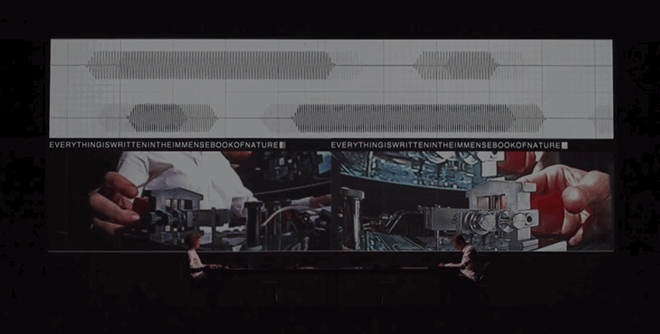Totally Trippy Perfomance Art
Reprinted from 

Ryoji Ikeda
Microfiche, crossword puzzles, and Morse Code don’t sound like the makings of a compelling live performance, but in the hands of Japanese maestro Ryoji Ikeda, these mundane materials become the core of a dynamic audio-visual spectacle called Superposition.
The hour-long performance is something like a high-tech rave with a year’s worth of high school science class schizophrenically drawn upon as its raw material. Twenty small monitors sit on the front of a stage with one theater-sized screen stretching behind two performers. What plays out is a little bit like a frenetic, abstract version of the Eames film Powers of Ten. Imagery flips rapidly between star maps and models of subatomic particles. Words spelled out in a 1950s split-flap style and the occasional full-color image of the Earth from above only enhance the connection to the midcentury classic.
Ikeda is best known for his experimental musical compositions with cryptic titles like +/-. To make the visual component that complements Superposition’s chorus of electronic sounds, the Paris-based composer worked with a team of three programmers to fill the screens with monochromatic, generative visuals.
Though it’s driven by software, Superposition is meant to be a human experience. A pair of performers, Stéphane Garin and Amélie Grould, are charged with interpreting the work. The duo acts like a variable in the software, tasked with merging the skill sets of DJs, Abstract Expressionist painters, and office drones.
Garin and Grould control Ikeda’s work through custom-made “instruments.” A Morse Code key is played in much the same way a concert pianist would play on a Steinway, except the result is an electronic staccato, with waveforms that criss-cross the screen like a game of pong. The noises sound random, but the performers are working off a prepared script, essentially sheet music, which dictates the messages sent to one another.
Superposition artfully combines human and machine capabilities. In one section, marbles are scattered on a platform, with their position interpreted into an image of a horizon presented in stroboscopic flashes. In his artist’s statement, Ikeda writes that Superposition was crafted to visualize the way we “understand the reality of nature on an atomic scale” and was “inspired by the mathematical notions of quantum mechanics.” You don’t need to worry about that though; just sit back and let the spectacle wash over you.

Ryoji Ikeda
Superposition has been touring the world in a variety of formats for the past two years and is slated to appear at the Automne en Normandie festival in France on December 2nd 2014.
More from Wired:
Future Tense is a partnership of Slate, New America, and Arizona State University.
